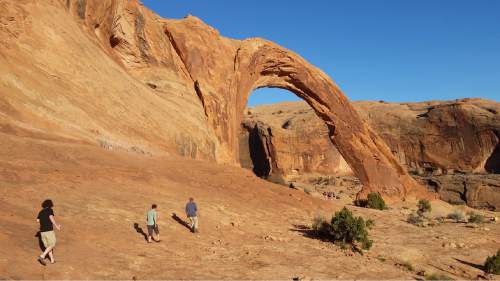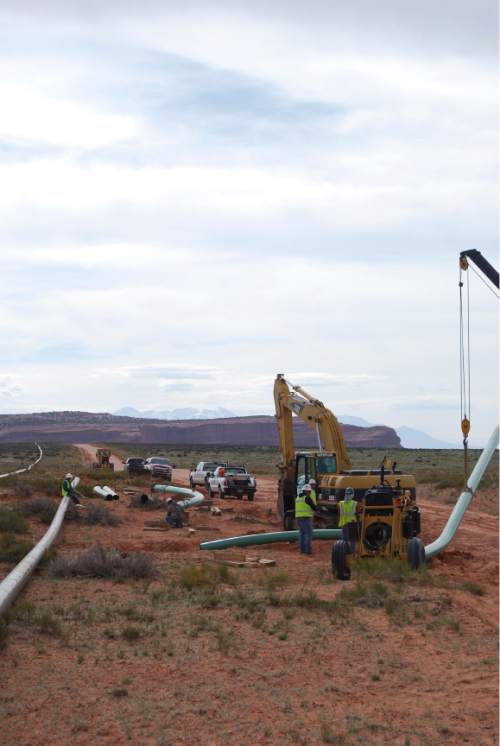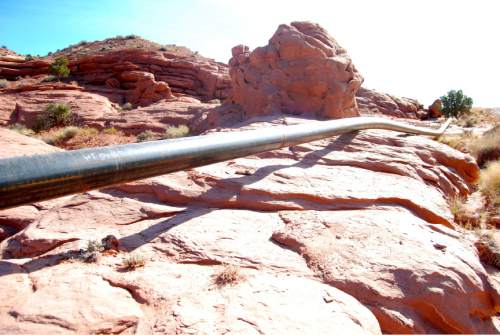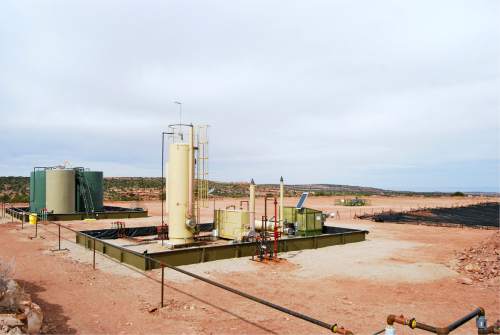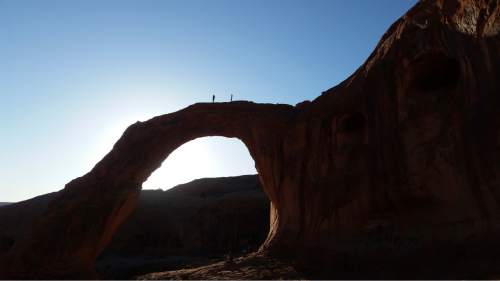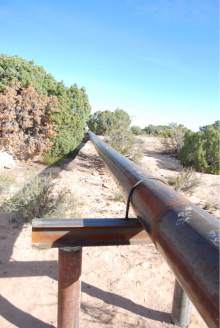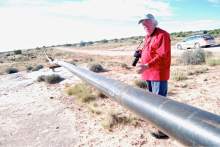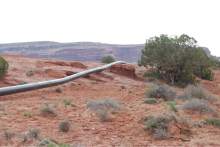This is an archived article that was published on sltrib.com in 2016, and information in the article may be outdated. It is provided only for personal research purposes and may not be reprinted.
Utah's first master lease plan, which would govern energy development on 785,000 acres of public land around Moab, is nearing completion with the release of a final Environmental Impact Statement identifying a preferred vision for balancing mineral extraction and recreation near two of Utah's iconic parks.
By year's end, the Bureau of Land Management hopes to finalize its Moab plan, one of five master lease plans, or MLPs, it has proposed for scenic lands in Utah specifying where oil and gas and potash leases may be issued in the future. The proposed plan would bar leasing on 145,000 acres adjacent to Canyonlands and Arches national parks and prohibit surface occupancy on another 306,000 acres.
Much of these lands are open for development under the BLM's Moab and Monticello resource management plans, prompting state leaders to complain that the plan "negates" the hard work that went into revising these plans in 2008.
"The analysis and proposed decisions do nothing but pile restriction upon restriction within particular areas, assuming that the restrictions will prevent harm to the recreational landscape, while simultaneously opining that a severely handicapped fluid mineral industry can still proceed in an economic fashion," wrote Kathleen Clarke, the governor's public lands policy director, in the state's official comments.
The Moab MLP drew kudos from environmental and recreation groups that heralded it as a template for responsible mineral management moving forward.
"They have responded to what diverse stakeholders have told them: that we need to balance all the economic values of public lands, and not favor some at the expense of others," said Chris Saeger of the Western Values Project. "If future presidential administrations want to avoid the conflicts that have come along with energy development on public lands, they would do well to continue the inclusiveness and collaboration that come with this new approach to managing public lands."
Others called it "a watershed moment for our national parks."
"The Moab master leasing plan recognizes that parks are part of larger landscapes that should be managed with care and cooperation with local communities and the National Park Service," said retired park superintendent Ellis Richard, founder of Park Rangers for Our Lands.
The plan would not extinguish existing leases covering 228,000 acres — about a third of the planning area. But these leases could be subject to new environmental safeguards, according to the BLM's acting Canyon Country district manager, Beth Ransel.
"It is putting a framework for responsible energy development, while still providing adequate protections for the outstanding recreation resources there," Ransel said. "Current leases would not be interfered with. ... One objective was to ensure more certainty for industry so when they would like to develop in this area, there would be more predictability."
The planning area includes the lands surrounding Arches and to the north and east of Canyonlands. Among the places that would earn additional protections are Fisher Towers, Porcupine Rim, Six-Shooter Peaks and Goldbar Canyon, all of which face pressure from energy development.
The Obama administration initiated master leasing following the intense controversies during the waning months of former President George W. Bush's tenure, when vast tracts of land near Utah parks went on the auction block. The idea was to perform careful analysis before leases are sold in areas with high recreational, scenic and natural value, rather than after, making the approval process for actual drilling smoother, proponents say.
"The proposed plan takes a landscape-level approach to balancing the protection of the iconic scenery in and around Moab and access to the rich energy resources found there," Interior Secretary Sally Jewell said in a news release. "As the first Master Leasing Plan in Utah, the collaborative process that led to the proposed plan should serve as a model for how communities can work together to balance development with the protection of world-class environmental, cultural and recreational resources."
The final EIS, which was posted on the Federal Register on Tuesday, opens a protest period through Aug. 22. A final decision is expected by the end of the year.
Industry and state officials, however, made clear they are not pleased with master leasing, denouncing it as a legally suspect process that adds unnecessary layers of review on leasing and development proposals.
"It needlessly locks away yet more lands without Congressional consent, closing 57 percent of the area to development while imposing redundant constraints on the remaining area that will make it extremely difficult to produce energy that all Americans own," said Kathleen Sgamma, vice president of government and public affairs at Western Energy Alliance. "It's simply about shutting down development."
Saeger rejected that characterization, noting the plan would close off 32 percent of the planning area to leasing. Much of the remaining acreage would be subject to protective measures that could complicate drilling.
"In the face of a historic compromise in Moab that included local officials, industry, recreational interests and millions of Americans, the only industry response is a misstatement of the facts that undermine the findings. Sgamma's comments are further proof that the oil and gas industry has no interest in compromise or engaging with western communities who are working day and night to support a diverse and vibrant economy in the West," he said.
The plan also identifies 58,300 acres for potash leasing where oil and gas leasing would not happen. State officials objected to this provision, arguing that it serves no purpose to segregate potash and energy leases.
"Leasing on the same tract can lead to a net reduction in infrastructure," Clarke's office wrote in the state comments. "Joint exploration operations near Hatch Point show that petroleum and potash companies work together to share roads, drilling pads and drill holes to minimize surface disturbance."
The state is urging the BLM to suspend the master leasing process in favor of legislative solutions to Utah's land-use conflicts sponsored by Rep. Jason Chaffetz and Rob Bishop.
Meanwhile, the BLM is preparing environmental reviews for MLPs covering the San Rafael Desert and for lands outside Cisco along the eastern Book Cliffs. Further down the pipeline are MLPs for lands outside Dinosaur National Monument and along the White River in the eastern reaches of the Uinta Basin and for San Juan County, including areas within the proposed Bears Ears National Monument.
Brian Maffly covers public lands for The Salt Lake Tribune. Maffly can be reached at bmaffly@sltrib.com or 801-257-8713. Twitter: @brianmaffly


